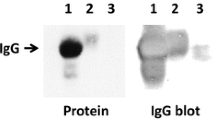Abstract
Carbohydrates are thought to function as tags that mark circulatory glycoproteins for rapid clearance. Scavenger endothelial cells (SECs) play the primary role in clearing glycoproteins via receptor-mediated endocytosis in adult animals. We found that horseradish peroxidase (HRP), a glycoprotein, was removed quickly, mostly by receptor mediation from the chicken embryo circulation, but bovine serum albumin was not. The half-life of HRP in the circulation varied with the embryo stage and fell rapidly from 0.73 h at embryonic day 4 (E4) to 0.23 h at E5, with no great difference among stages after E5. HRP clearance was far slower at E3.5 than at E5, but was obviously suppressed by mannan. These results imply that the function of clearing glycoprotein or waste macromolecules from the circulation via receptor-mediated endocytosis appears early in the embryo.
Similar content being viewed by others
References
Ashwell, G., and Morell, A.G. (1974): The role of surface carbohydrates in the hepatic recognition and transport of circulating glycoproteins.Adv Enzymol Relat Areas. Mol Biol,4l, 99–128.
Bondada, S. and Robertson, D.A. (2003): Assays for B Cell Function.In “Current protocols in immunology” (J. E. Colijan, A. M. Kruisbeek, D. M. Marguiles, E. M. Shevach and W. Strober, eds.), John Wiley and Sons, Inc., New York, pp. 333–334.
Dini, L., and Mattioli, P. (1990): Carbohydrate recognition systems in avian sinusoidal liver cells.Biosci Rep,10, 37–46.
Einarsson, M., Pertoft, H., and Smedsrod, B. (1985): Endocytosis of tissue plasminogen activator (tPA) by rat liver cells.Thromb Haemostas,54, 270.
Freeman, B.M., and Vince, M.A. (1974): “Development of the Avian Embryo: A Behavioural and Physiological Study,” Chapman & Hall, London.
Goldstein, J.L., Ho, Y.K., Basu, S.K., and Brown, M.S. (1979): Binding Site on Macrophages that Mediates Uptake and Degradation of Acetylated Low Density Lipoprotein, Producing Massive Cholesterol Deposition.Proc Natl Acad Sci USA,76, 333–337.
Kawasaki, T., and Ashwell, G. (1977): Isolation and characterization of an avian hepatic binding protein specific for N-acetylglucosamine-terminated glycoproteins.J Biol Chem,252, 6536–6543.
Lee, S.J., Evers, S., Roeder, D., Parlow, A.F., Risteli, J., Risteli, L., Lee, Y.C., Feizi, T., Langen, H., and Nussenzweig, M.C. (2002): Mannose receptor-mediated regulation of serum glycoprotein homeostasis.Science,295, 1898–1901.
Malovic, I., Sorensen, K.K., Elvevold, K.H., Nedredal, G.I., Paulsen, S., Erofeev, A.V., Smedsrod, B.H., and McCourt, P.A. (2007): The mannose receptor on murine liver sinusoidal endothelial cells is the main denatured collagen clearance receptor.Hepatology,45, 1454–1461.
Mego, J.L., Bertini, F., and McQueen, J.D. (1967): The use of formaldehyde-treated 131I-albumin in the study of digestive vacuoles and some properties of these particles from mouse liver.J Cell Biol,32, 699–707.
Rockey, D.C., and Bissell, D.M. (2006): Noninvasive measures of liver fibrosis.Hepatology,43, S113-S120.
Sallusto, F. (1995): Dendritic cells use macropinocytosis and the mannose receptor to concentrate macromolecules in the major histocompatibility complex class II compartment: downregulation by cytokines and bacterial products.J Exp Med,182, 389–400.
Seternes, T., Sorensen, K., and Smedsrod, B. (2002): Scavenger endothelial cells of vertebrates: A nonperipheral leukocyte system for highcapacity elimination of waste macromolecules.Proc Natl Acad Sci USA,99, 7594.
Smedsrød, B. (2004): Clearance function of scavenger endothelial cells.Comp Hepatol,3, S22.
Sugimoto, Y., Sanuki, S., Ohsako, S., Higashimoto, Y., Kondo, M., Kurawaki, J., Ibrahim, H.R., Aoki, T., Kusakabe, T., and Koga, K. (1999): Ovalbumin in Developing Chicken Eggs Migrates from Egg White to Embryonic Organs while Changing Its Conformation and Thermal Stability.J Biol Chem,274, 11030–11037.
Taylor, P.R., Gordon, S., and Martínez-Pomares, L. (2005): The mannose receptor: linking homeostasis and immunity through sugar recognition.Trends Immunol,26, 104–110.
Author information
Authors and Affiliations
Corresponding author
Rights and permissions
About this article
Cite this article
Wu, G., Li, Z. Glycoprotein clearance is rapid and suppressed by mannan in chicken embryos. J Physiol Biochem 65, 235–241 (2009). https://doi.org/10.1007/BF03180576
Received:
Issue Date:
DOI: https://doi.org/10.1007/BF03180576




